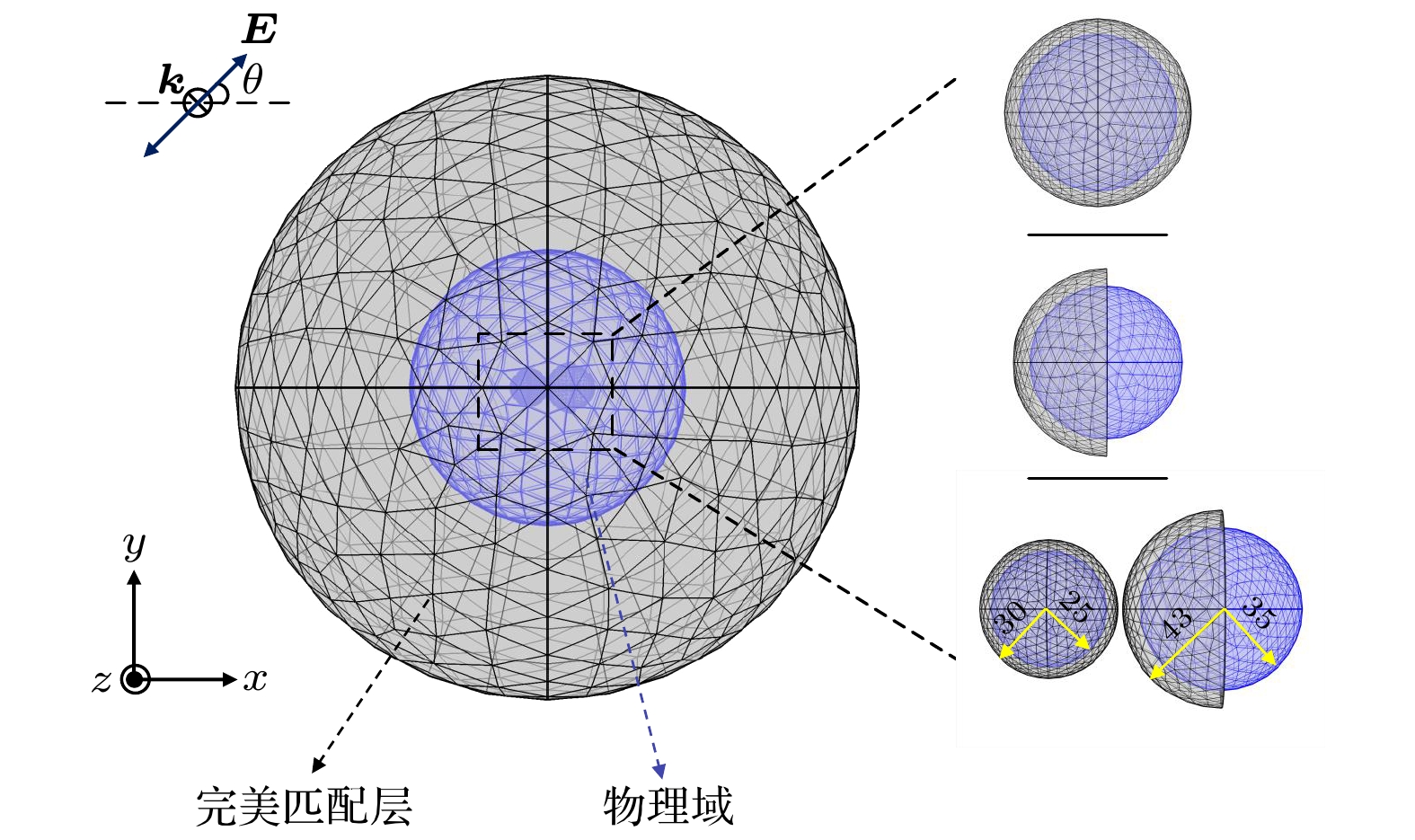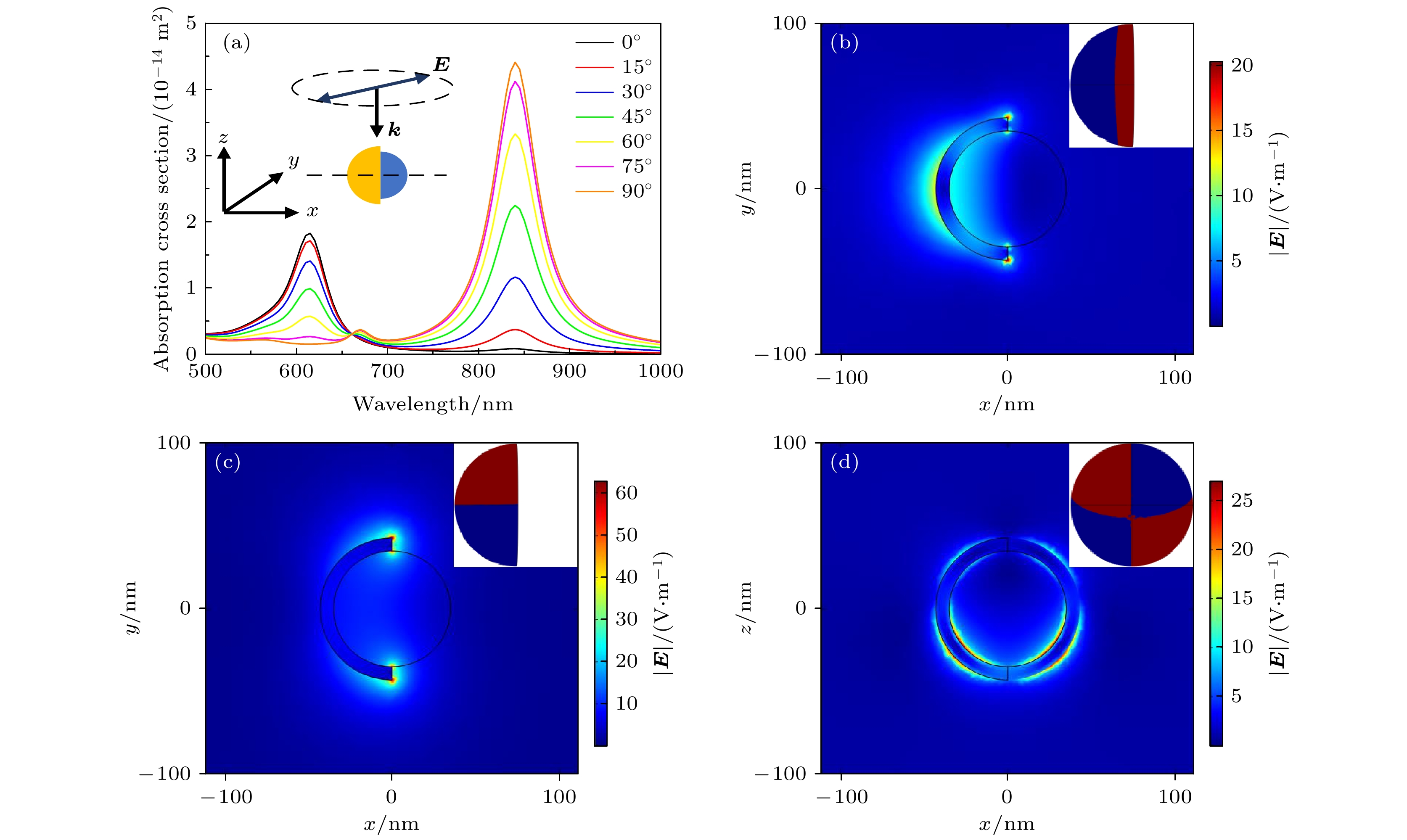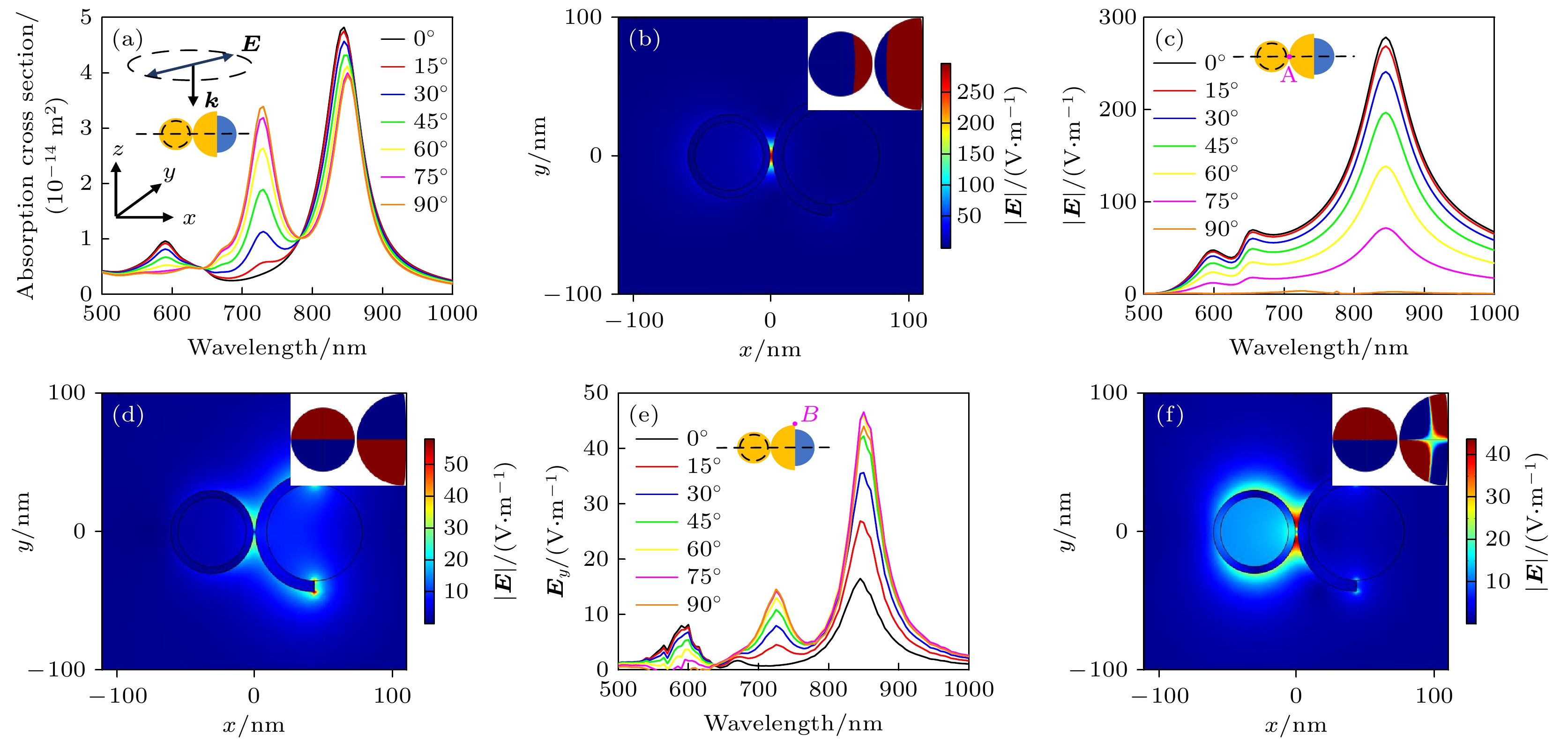-
各向异性贵金属纳米结构所特有的表面增强电场和近红外性能在纳米光电和生医传感等领域具有重要的应用, 但是其最佳光学性能的激发受限于结构姿态与光电场偏振方向的匹配. 本文基于芯帽颗粒特有的两个表面等离子体共振模式, 提出引入补偿结构, 利用二聚体结构间的局部表面等离子体共振耦合作用补偿电场偏转时缺失的近红外性能, 实现解除对激发光偏振方向的依赖关系. 基于有限元法数值求解了光与三维复杂异构二聚体作用后的电磁场分布, 分析了芯帽-芯壳异构二聚体间的作用模式, 从理论上明确了补偿结构去除偏振依赖的机理. 补偿后, 芯帽异构二聚体可在任意姿态下产生稳定的近红外高吸收性能, 在传感、成像、药物释放与光热疗法中具有广泛的应用潜力.
-
关键词:
- 局部表面等离子体共振 /
- 芯帽结构 /
- 偏振 /
- 有限元
The plasmonic anisotropic nanostructure possesses the enhanced surface electric field and unique optical properties in near-infrared spectrum, thus it has potential applications in nano-optoelectronics and medical sensing. To obtain the best property, the excitation polarization normally needs to match the orientation of the structure. The strong polarization dependence, however, greatly limits the excitation efficiency. In this work, a patchy structure is introduced to release the dependence of polarization. In the proposed method here in this work, the lost properties due to unmatched polarizations are compensated for by the plasmonic resonance coupling between the patch and capped structure in the heterozygous dimer. By overlapping the two modes at the same wavelength, the absorption keeps rather stable undisturbed status during the variation of incident polarization. This work focuses on the theoretical exploration of the feasibility. Electromagnetic field in the interaction between light and heterozygous dimer is essential before extinction coefficient is calculated. The field of the model is obtained by solving Maxwell equations through using the finite element method. The numerical calculation presents a good understanding of the mechanism of the plasmonic interactions in the dimer, based on which the nanostructure with optimized configuration parameters can achieve the stable and high absorption in the near infrared wavelength.-
Keywords:
- localized surface plasmon resonance /
- capped structure /
- polarization /
- finite-element method
[1] Petryayeva E, Krull U J 2011 Anal. Chim. Acta 706 8
 Google Scholar
Google Scholar
[2] Zhang X, Chen Y L, Liu R S, Tsai D P 2013 Rep. Prog. Phys. 76 046401
 Google Scholar
Google Scholar
[3] Mayer K M, Hafner J H L 2011 Chem. Rev. 111 3828
 Google Scholar
Google Scholar
[4] Lim D K, Jeon K S, Kim H M, Nam J M, Suh Y D 2010 Nat. Mater. 9 60
 Google Scholar
Google Scholar
[5] LiuY, Huang W, Chen W, Wang X, Guo J, Tian H, Zhang H, Wang Y, Yu B, Ren T L 2019 Appl. Surf. Sci. 481 1127
 Google Scholar
Google Scholar
[6] MaX, Sun H, Wang Y, Wu X, Zhang J 2018 Nano Energy 53 932
 Google Scholar
Google Scholar
[7] Sarah U, Ian B, He J, Laura S 2015 Sensors 15 15684
 Google Scholar
Google Scholar
[8] Loiseau A, Asila V, Boitel-Aullen G, Lam M, Salmain M, Boujday S 2019 Biosensors 9 78
 Google Scholar
Google Scholar
[9] Mejía-Salazar J R, Oliveira O N 2018 Chem. Rev. 118 10617
 Google Scholar
Google Scholar
[10] Cobley C, Chen J, Cho E, Wang L, Xia Y 2010 Chem. Soc. Rev. 40 44
 Google Scholar
Google Scholar
[11] He M Q, Yu Y L, Wang J H 2020 Nano Today 35 101005
 Google Scholar
Google Scholar
[12] Ren Q Q, Bai L Y, Zhang X S, Ma Z Y, Bo L, Zhao Y D, Cao Y C 2015 J. Nanomater. 2015 1
 Google Scholar
Google Scholar
[13] Dickerson E B, Dreaden E C, Huang X, El-Sayed I H, Chu H, Pushpanketh S 2008 Cancer Lett. 269 57
 Google Scholar
Google Scholar
[14] AustinL A, Mackey M A, Dreaden E C, El-Sayed M A 2014 Arch. Toxicol. 88 1391
 Google Scholar
Google Scholar
[15] Lin H C, Hsu K F, Lai C L, Wu T C, Lai C H 2020 Molecules 25 1853
 Google Scholar
Google Scholar
[16] Sun M, Lee, Joon H, Kim, You J, Ha, Nyun Y, Park, Kon S, Beom Y 2013 ACS Nano 7 50
 Google Scholar
Google Scholar
[17] Qin Z, Bischof J C 2012 Chem.Soc.Rev 41 1191
 Google Scholar
Google Scholar
[18] Mie G 1908 Ann. Phys. 330 337
 Google Scholar
Google Scholar
[19] Kelly K L, E C oronado, Lin L Z, Schatz G C 2003 J. Phys. Chem. B 107 668
 Google Scholar
Google Scholar
[20] Kabashin A V, Evans P, Pastkovsky S, HenDren W, Wurtz G A, Atkinson R, Pollard R, Podolskiy V A, Zayats A V 2009 Nat. Mater. 8 867
 Google Scholar
Google Scholar
[21] Kenneth, Grattan, Tong, Sun, Jie, Cao 2014 Sensors and Actuators, B. Chemical 195 332
 Google Scholar
Google Scholar
[22] Nehl C L, Liao H, Hafner J H 2006 Nano Lett. 6 683
 Google Scholar
Google Scholar
[23] Kumar R, Badilescu S, Packirisamy M 2019 J. Nanosci. Nanotechnol. 19 4617
 Google Scholar
Google Scholar
[24] Lee D, Yoon S 2015 J. Phys. Chem. C 119 7873
 Google Scholar
Google Scholar
[25] Boerigter C, Campana R, Morabito M 2015 Nat. Commun. 7 10545
 Google Scholar
Google Scholar
[26] Funston A M, Novo C, Davis T J, Mulvanet P 2009 Nano Lett. 9 1651
 Google Scholar
Google Scholar
[27] Zhu X P, Chen Y Q, Shi H M, Zhang S, Liu Q H, Duan H G 2017 J. Appl. Phys. 121 213105
 Google Scholar
Google Scholar
[28] Cui Y, Zhou J, Tamma V A, Park W 2012 ACS Nano 6 2385
 Google Scholar
Google Scholar
[29] Lovera A, Gallinet B, Nordlander P, Martin O J F 2013 ACS Nano 7 4527
 Google Scholar
Google Scholar
[30] Lassiter J B, Sobhani H, Fan J A, Kundu J, Capasso F, Nordlander P, Halas N J 2010 Nano Lett. 10 3184
 Google Scholar
Google Scholar
[31] Liu N, Weiss T, Mesch M, Langguth L, Eigenthaler U, Hirscher M, Nnichsen C, Giessen H 2010 Nano Lett. 10 1103
 Google Scholar
Google Scholar
[32] Dijk M A V, Tchebotareva A L, Orrit M, Lippitz M, Lounis B 2006 Phys. Chem. Chem. Phys. 8 3486
 Google Scholar
Google Scholar
[33] Gans R, Über D 1912 Ann. Phys. 342 881
 Google Scholar
Google Scholar
[34] Ye J, Dorpe P V, Roy W V, Lodewijks K, Vlaminck I D, Maes G, Borghs G 2009 J. Phys. Chem. C 113 3110
 Google Scholar
Google Scholar
[35] Nordlander P, Oubre C 2004 Nano Lett. 4 899
 Google Scholar
Google Scholar
[36] Kerker M 1985 J. Colloid Interface Sci. 105 297
 Google Scholar
Google Scholar
[37] Knight M W, Halas N J 2008 New J. Phys. 10 119
 Google Scholar
Google Scholar
[38] Chen Q, Qi H, Ren Y T, Sun J P, Ruan L M 2017 AIP Adv. 7 065115
 Google Scholar
Google Scholar
[39] Lassiter J B, Knight M W, Mirin N A, Halas N J 2009 Nano Lett. 9 4326
 Google Scholar
Google Scholar
[40] 洪昕, 王晨晨 2018 光学学报 38 0524001
 Google Scholar
Google Scholar
Hong X, Wang C C 2018 Acta Opti. Sin. 38 0524001
 Google Scholar
Google Scholar
[41] Ye J, Kong Y, Liu C 2016 J. Phys. D:Appl. Phys. 49 205106
 Google Scholar
Google Scholar
[42] Cortie M, Ford M 2007 Nanotechnology 18 235704
 Google Scholar
Google Scholar
[43] 洪昕 2020 中国专利 ZL202010038295.7
Hong X 2020 Chinese Patent CN111204705A (in Chinese)
-
图 2 芯壳结构纳米单颗粒的LSPR 振动模式 (a) 线偏振光激发下的芯壳结构单颗粒的吸收谱线; (b) 715 nm峰值吸收谱线上的电场分布, 插图中的电荷极化分布图表明该振动为电偶极子模式; (c) 在吸收谱线600 nm处的电场分布, 插图中的电荷极化分布图表明该振动为四极子模式
Fig. 2. Plasmonic resonance mode of an individual core-shell nano-structure:(a) The absorption spectrum excited by a linear polarization; (b) the electric field distribution at 715 nm is a dipolar mode indicated by the charge distribution shown in the inset; (c) the electric field distribution at 600 nm is a quadripolar mode indicated by the charge distribution shown in the inset.
图 3 芯帽结构纳米单颗粒的LSPR 振动模式 (a) 线偏振光激发下芯帽结构单颗粒的吸收谱线随偏振方向的变化曲线; (b)对应谱线615 nm处的电场分布, 插图中的电荷极化分布图表明该振动模式为电偶极子; (c) 对应谱线840 nm处的电场分布集中在帽沿上, 插图中电荷极化分布图表明该模式受激于平行于帽沿平面的电场; (d) 对应谱线670 nm处的电场分布和电荷极化分布, 表明该模式为四极子模式
Fig. 3. Plasmonic resonance mode of an individual capped nano-structure: (a) The absorption spectrum variation with polarization rotating from 0° to 90°; (b) the electric field distribution at 615 nm is a dipolar mode indicated by the charge distribution shown in the inset; (c) at 840 nm, the resonance is known as a magnetic mode with electric field accumulated at the brim, while the charge distribution in the inset indicates the polarization direction along the brim; (d) the electric field distribution at 670 nm is a quadripolar mode indicated by the charge distribution shown in the inset.
图 4 芯帽-芯壳异构二聚体的LSPR耦合作用 (a)在线偏振光激发下二聚体颗粒的吸收谱线随偏振方向旋转的变化关系; (b) 对应谱线峰值845 nm处0°电场激发下的异构体的电场分布及电荷极化分布; (c) 异构体间隙A点处电场随激发光偏振方向旋转的变化谱线; (d) 对应谱线峰值850 nm处90°电场激发下异构体的电场分布及电荷极化分布; (e) 帽沿B点处电场随偏振方向的变化谱线; (f) 对应谱线730 nm处异构体间LSPR耦合作用的电场及电荷极化分布图
Fig. 4. Plasmonic interaction between the patch/capped structures in the heterozygous dimer: (a) Excited by linear polarization, the absorption spectrum variation with polarization rotation; (b) at 845 nm, the “hot spot” at the gap in the electric field distribution shows the strong plasmonic coupling between the two modes, as shown in the inset; (c) the electric field at the point A of gap varies with the polarization direction; (d) at 850 nm, the strong electric field is contributed by the capped structure and the distribution at the brim clearly indicates the magnetic mode when the polarization is 90°; (e) the spectrum variation at point B on the brim with polarization rotation from 0° to 90°; (f) at 730 nm, the electric field distribution clear shows the shell dominates the contribution.
图 5 芯帽异构二聚体的近红外吸收性能 (a) 芯帽异构二聚体与芯帽单颗粒的近红外吸收性能对偏振态依赖关系的对比; (b) 芯帽异构二聚体在空间随机角度入射下产生稳定的高吸收
Fig. 5. Absorption properties of the heterozygous dimer at near infrared: (a) The dimer exhibits a rather “flat” line compared to the individual capped structure during the polarization rotation; (b) with random incident angle, the dimer still keeps a stable high absorption at the near infrared wavelength when the polarization rotates.
-
[1] Petryayeva E, Krull U J 2011 Anal. Chim. Acta 706 8
 Google Scholar
Google Scholar
[2] Zhang X, Chen Y L, Liu R S, Tsai D P 2013 Rep. Prog. Phys. 76 046401
 Google Scholar
Google Scholar
[3] Mayer K M, Hafner J H L 2011 Chem. Rev. 111 3828
 Google Scholar
Google Scholar
[4] Lim D K, Jeon K S, Kim H M, Nam J M, Suh Y D 2010 Nat. Mater. 9 60
 Google Scholar
Google Scholar
[5] LiuY, Huang W, Chen W, Wang X, Guo J, Tian H, Zhang H, Wang Y, Yu B, Ren T L 2019 Appl. Surf. Sci. 481 1127
 Google Scholar
Google Scholar
[6] MaX, Sun H, Wang Y, Wu X, Zhang J 2018 Nano Energy 53 932
 Google Scholar
Google Scholar
[7] Sarah U, Ian B, He J, Laura S 2015 Sensors 15 15684
 Google Scholar
Google Scholar
[8] Loiseau A, Asila V, Boitel-Aullen G, Lam M, Salmain M, Boujday S 2019 Biosensors 9 78
 Google Scholar
Google Scholar
[9] Mejía-Salazar J R, Oliveira O N 2018 Chem. Rev. 118 10617
 Google Scholar
Google Scholar
[10] Cobley C, Chen J, Cho E, Wang L, Xia Y 2010 Chem. Soc. Rev. 40 44
 Google Scholar
Google Scholar
[11] He M Q, Yu Y L, Wang J H 2020 Nano Today 35 101005
 Google Scholar
Google Scholar
[12] Ren Q Q, Bai L Y, Zhang X S, Ma Z Y, Bo L, Zhao Y D, Cao Y C 2015 J. Nanomater. 2015 1
 Google Scholar
Google Scholar
[13] Dickerson E B, Dreaden E C, Huang X, El-Sayed I H, Chu H, Pushpanketh S 2008 Cancer Lett. 269 57
 Google Scholar
Google Scholar
[14] AustinL A, Mackey M A, Dreaden E C, El-Sayed M A 2014 Arch. Toxicol. 88 1391
 Google Scholar
Google Scholar
[15] Lin H C, Hsu K F, Lai C L, Wu T C, Lai C H 2020 Molecules 25 1853
 Google Scholar
Google Scholar
[16] Sun M, Lee, Joon H, Kim, You J, Ha, Nyun Y, Park, Kon S, Beom Y 2013 ACS Nano 7 50
 Google Scholar
Google Scholar
[17] Qin Z, Bischof J C 2012 Chem.Soc.Rev 41 1191
 Google Scholar
Google Scholar
[18] Mie G 1908 Ann. Phys. 330 337
 Google Scholar
Google Scholar
[19] Kelly K L, E C oronado, Lin L Z, Schatz G C 2003 J. Phys. Chem. B 107 668
 Google Scholar
Google Scholar
[20] Kabashin A V, Evans P, Pastkovsky S, HenDren W, Wurtz G A, Atkinson R, Pollard R, Podolskiy V A, Zayats A V 2009 Nat. Mater. 8 867
 Google Scholar
Google Scholar
[21] Kenneth, Grattan, Tong, Sun, Jie, Cao 2014 Sensors and Actuators, B. Chemical 195 332
 Google Scholar
Google Scholar
[22] Nehl C L, Liao H, Hafner J H 2006 Nano Lett. 6 683
 Google Scholar
Google Scholar
[23] Kumar R, Badilescu S, Packirisamy M 2019 J. Nanosci. Nanotechnol. 19 4617
 Google Scholar
Google Scholar
[24] Lee D, Yoon S 2015 J. Phys. Chem. C 119 7873
 Google Scholar
Google Scholar
[25] Boerigter C, Campana R, Morabito M 2015 Nat. Commun. 7 10545
 Google Scholar
Google Scholar
[26] Funston A M, Novo C, Davis T J, Mulvanet P 2009 Nano Lett. 9 1651
 Google Scholar
Google Scholar
[27] Zhu X P, Chen Y Q, Shi H M, Zhang S, Liu Q H, Duan H G 2017 J. Appl. Phys. 121 213105
 Google Scholar
Google Scholar
[28] Cui Y, Zhou J, Tamma V A, Park W 2012 ACS Nano 6 2385
 Google Scholar
Google Scholar
[29] Lovera A, Gallinet B, Nordlander P, Martin O J F 2013 ACS Nano 7 4527
 Google Scholar
Google Scholar
[30] Lassiter J B, Sobhani H, Fan J A, Kundu J, Capasso F, Nordlander P, Halas N J 2010 Nano Lett. 10 3184
 Google Scholar
Google Scholar
[31] Liu N, Weiss T, Mesch M, Langguth L, Eigenthaler U, Hirscher M, Nnichsen C, Giessen H 2010 Nano Lett. 10 1103
 Google Scholar
Google Scholar
[32] Dijk M A V, Tchebotareva A L, Orrit M, Lippitz M, Lounis B 2006 Phys. Chem. Chem. Phys. 8 3486
 Google Scholar
Google Scholar
[33] Gans R, Über D 1912 Ann. Phys. 342 881
 Google Scholar
Google Scholar
[34] Ye J, Dorpe P V, Roy W V, Lodewijks K, Vlaminck I D, Maes G, Borghs G 2009 J. Phys. Chem. C 113 3110
 Google Scholar
Google Scholar
[35] Nordlander P, Oubre C 2004 Nano Lett. 4 899
 Google Scholar
Google Scholar
[36] Kerker M 1985 J. Colloid Interface Sci. 105 297
 Google Scholar
Google Scholar
[37] Knight M W, Halas N J 2008 New J. Phys. 10 119
 Google Scholar
Google Scholar
[38] Chen Q, Qi H, Ren Y T, Sun J P, Ruan L M 2017 AIP Adv. 7 065115
 Google Scholar
Google Scholar
[39] Lassiter J B, Knight M W, Mirin N A, Halas N J 2009 Nano Lett. 9 4326
 Google Scholar
Google Scholar
[40] 洪昕, 王晨晨 2018 光学学报 38 0524001
 Google Scholar
Google Scholar
Hong X, Wang C C 2018 Acta Opti. Sin. 38 0524001
 Google Scholar
Google Scholar
[41] Ye J, Kong Y, Liu C 2016 J. Phys. D:Appl. Phys. 49 205106
 Google Scholar
Google Scholar
[42] Cortie M, Ford M 2007 Nanotechnology 18 235704
 Google Scholar
Google Scholar
[43] 洪昕 2020 中国专利 ZL202010038295.7
Hong X 2020 Chinese Patent CN111204705A (in Chinese)
计量
- 文章访问数: 5924
- PDF下载量: 52
- 被引次数: 0














 下载:
下载:




